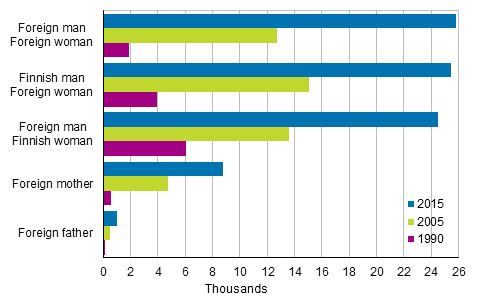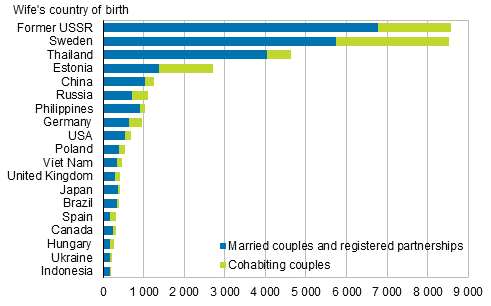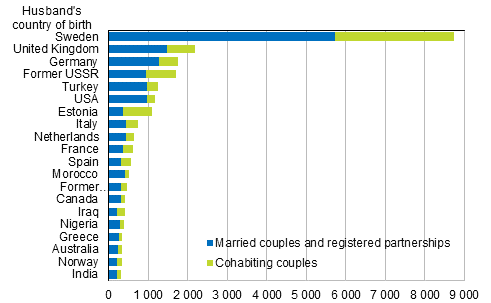2. Four per cent of families entirely foreign-language speaking
In 86 per cent of all families, the only parent or both parents are Finnish-speaking. Correspondingly, four per cent of families are entirely Swedish-speaking. Families where one spouse is Swedish-speaking and the other Finnish-speaking account for three per cent of all families. Combinations of Finnish and Swedish-speakers with other languages can be found in around four per cent of all families. Families where both of the spouses or the only parent are foreign-language speakers number 59,200, which equals four per cent of all families.
In clearly more cases Swedish-speaking men have Finnish-speaking spouses than Swedish-speaking women Finnish-speaking spouses. The number of purely Swedish-speaking couples is only 3,800 higher than that of Finnish and Swedish-speaking couples.
Altogether, 29,700 Finnish or Swedish-speaking men are married to or cohabiting with a foreign-language speaking woman. The corresponding figure for women is 23,400. Unions with foreign-language speakers increased by 2,100 in 2015.
Table 4. Families speaking Finnish, Swedish or other language in 1990–2015
| Man/woman finnish speaking or foreign speaking |
Year | |||||
| 1990 | 1995 | 2000 | 2005 | 2010 | 2015 | |
| Finnish speaking man and finnish speaking woman |
1 088 742 | 1 081 473 | 1 089 232 | 1 105 316 | 1 114 828 | 1 106 115 |
| Finnish speaking man and swedish speaking woman |
16 544 | 16 876 | 17 394 | 17 904 | 18 337 | 18 527 |
| Finnish speaking woman and swedish speaking man |
22 734 | 22 822 | 23 445 | 24 218 | 24 552 | 24 693 |
| Finnish speaking man and foreign speaking woman |
4 020 | 7 636 | 11 094 | 16 062 | 21 772 | 28 101 |
| Finnish speaking woman and foreign speaking man |
5 951 | 8 679 | 10 236 | 13 181 | 17 441 | 22 211 |
| Finnish speaking mother/father |
162 209 | 174 554 | 174 861 | 166 741 | 161 302 | 158 233 |
| Swedish speaking man and swedish speaking woman |
53 348 | 50 845 | 49 198 | 48 190 | 47 881 | 46 982 |
| Swedish speaking man and foreign speaking woman |
300 | 483 | 655 | 982 | 1 434 | 1 882 |
| Swedish speaking woman and foreign speaking man |
410 | 597 | 678 | 943 | 1 261 | 1 595 |
| Swedish speaking mother/father |
8 489 | 8 871 | 8 609 | 8 147 | 7 953 | 7 856 |
| Foreign speaking man and foreign speaking woman |
1 832 | 7 425 | 11 668 | 16 944 | 27 638 | 43 527 |
| Foreign speaking mother/father |
762 | 2 709 | 4 893 | 7 374 | 10 674 | 15 638 |
2.1 Majority of foreign-language families are Russian speakers
The largest foreign-language group in Finland is made up of Russian speakers. At the end of 2015, there were 14,800 such Russian-speaking families in Finland in which the native language of the only parent or both parents was Russian. The number of families where either one of the spouses is Russian-speaking is slightly lower at 13,000. The number of Russian-speaking families is 900 higher than in the year before.
The number of Russian-speaking one-parent families is 4,100, which is 15 per cent of all Russian-speaking families. Among Russian-speakers, one-parent families are clearly more common than one-parent families are of all one-parent families (12%). Of Russian-speaking one-parent families, 95 per cent are formed by mothers and children, while this is so for 83 per cent of all families with one parent.
The most common language combination among the Russian-speaking families is one where the husband and the wife speak Russian. In the course of 2015, the number of such couples has risen by 400. In 1990, there were only 300 Russian-speaking couples in Finland, today their number has gone up to 10,600.
The second most common language combination in Russian-speaking families is a Finnish-speaking husband and a Russian-speaking wife (8,500). It is still rare for a Finnish-speaking woman to have a Russian-speaking spouse. At the end of 2015, their number was 1,600.
2.2 Families of Estonian and Russian citizens are most common families of foreign citizens
In only six per cent (94,800 families) of all families in Finland at least one of the spouses or the only parent is a foreign citizen. There were only 12,500 such families in Finland in 1990 and as many as 36,000 in 2000. In the past year, the number of such families has increased by 1,300. The number of families in which both the husband and wife are foreign nationals grew the most.
In the early 1990s, the most common combination in families of foreign citizens was one where the wife was a Finnish citizen and the husband a foreign citizen. The number of foreign families in which the wife was a foreign national and the husband a Finnish national was the largest at the beginning of the 2000s. In 2013, the most common combination in families of foreign citizens was still one where the husband is a Finnish citizen and the wife a foreign citizen. In 2014, families of two foreign spouses have become the most common family types of families of foreign citizens, but with a narrow margin. Now the number of families formed by two foreign spouses is 25,900 (Figure 3). No distinction is made between married and cohabiting couples here.
In families where at least one of the spouses or the only parent is a foreign citizen, the largest group of foreign citizens is families with Estonian citizens, 14,700. In turn, families of Russian citizens numbered 12,100.
Entirely foreign families, i.e. families where the only parent or both spouses are foreign citizens, total 35,600. There were 5,400 families where the only parent or both spouses are Russian citizens at the end of 2015. There were 9,100 entirely Estonian families of which 30 per cent were families consisting of mother and children only. The number of Estonian families increased by 300 from the year before. Families of two Chinese citizens or with one Chinese parent numbered 1,300. The number of these families grew by 70 from the previous year. Eleven per cent of the families of Chinese citizens are families of mother and children only.
Figure 3. Families of foreign citizens in 1990, 2005 and 2015

2.3 Women's and men's foreign-born spouses from different countries
An examination of countries of birth gives the best picture of the foreign spouses of Finns. However, it should be borne in mind that some children of two Finnish citizens are also born abroad. Finnish-born men have 39,600 foreign-born spouses. The number has grown by 800 from the year before. Finnish-born women have 33,800 foreign-born spouses; the number having grown by 900. Today, Finnish men more often have spouses with foreign background than Finnish women.
The foreign-born spouses of Finnish men and women come from a variety of countries. Men's spouses were born mainly in the neighbouring countries and East Asia. Those born in the area of the former Soviet Union cannot be separated into Russians or Estonians (or those born in other republics of the former Soviet Union), because even the Estonians' country of birth is mostly the Soviet Union and a large number of the spouses from Estonia had already moved to Finland before the collapse of the Soviet Union. Finnish men have 12,400 spouses who were born in the former Soviet Union, Russia or Estonia, and 8,500 spouses who were born in Sweden. The number of spouses born in Thailand is 4,600. The next most common countries of birth for the spouses were China, the Philippines, Germany, the United States and Poland.
Women's foreign-born spouses come from a larger variety of countries than men's spouses. The number of spouses born in Sweden is 8,700. Husbands born in the former Soviet Union, Russia and Estonia number 3,000, which is approximately one hundred more than in the year before. The next most frequent countries of birth of Finnish women' foreign spouses are Great Britain, Germany, Turkey and the USA.
Figure 4A. Foreign-born spouses of Finnish-born men by country of birth in 2015

Figure 4B. Foreign-born spouses of Finnish-born women by country of birth in 2015

Source: Population and Justice Statistics, Statistics Finland
Inquiries: Eevi Lappalainen 029 551 3367, Timo Nikander 029 551 3250 , Marjut Pietil�inen 029 551 2798, info@stat.fi
Director in charge: Jari Tarkoma
Updated 25.11.2016
Official Statistics of Finland (OSF):
Families [e-publication].
ISSN=1798-3231. Annual Review 2015,
2. Four per cent of families entirely foreign-language speaking
. Helsinki: Statistics Finland [referred: 19.4.2025].
Access method: http://stat.fi/til/perh/2015/02/perh_2015_02_2016-11-25_kat_002_en.html

